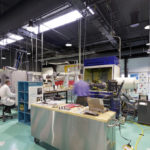Effective childcare programs for children with ASD – yes we can!
Standard community services often don’t have the resources to support intensive home programs for pre-schoolers with autism. Dr Giacomo Vivanti shares research on how an effective intervention model can be delivered successfully in a childcare setting.
There is increasing evidence that intensive implementation of educational programs can be efficacious in improving outcomes in young children with autism. One of the most promising early intervention programs is the Early Start Denver Model (ESDM), a play-based intervention specifically targeting the educational needs of pre-schoolers with autism. Research conducted in the US indicates that the program is efficacious in the context of intensive individual home treatment.
However, as standard community services often lack the resources needed to support intensive, individual home programs, very few families currently have access to this therapy.
Our recent study carried out at the La Trobe University Victorian ASELCC (Autism Specific Learning and Care Centre) , in collaboration with OTARC and the MIND Institute, addressed this critical issue by documenting that the ESDM can be delivered successfully in the context of community childcare settings.
As opposed to the US study, the Victorian ASELCC team implemented the ESDM within the constraints and the resources of a childcare setting, using regular childcare teachers and a child-staff ratio of 1:3. Families accessing the program were paying a standard childcare fee. We measured the outcomes of 27 pre-schoolers with ASD receiving 15–25 hours per week of ESDM therapy over 12 months compared to those of 30 peers with ASD undergoing a generic intervention program delivered in a similar community long-day care service. While children in both groups made significant improvements, those receiving ESDM showed significantly higher gains in language (20 Developmental Quotient points versus 10 in the control group) and cognition (14 Developmental Quotient points versus 7 in the control group).
Despite these remarkable gains at the group-level, there were important individual differences in the gains made by children receiving the program, with some children making slow but steady progress (30%), others that achieved a “normal” developmental rate (25%), and others showing an acceleration of their developmental rate, thus greatly reducing or eliminating the gap with the cognitive level expected for their age (45%). At the beginning of the program, only 40% percent of the children in the ESDM program had language – after 12 months, the proportion of verbal children was 90%.
These findings point to the importance of understanding individual learning profiles in response to treatment. In a recent article we analysed the literature on early intervention, and found that while variability in response to treatment is very common, there is very little knowledge on what are the characteristics that distinguish children that respond rapidly to early intervention from those who respond slowly. To address this issue, we have conducted a fine-grained analysis of the learning profiles of children undergoing our program, and found that children who had more spontaneous imitation play and joint attention skills showed the most sizeable progress.
Another significant step introduced in our research program is the use of psychophysiological measures to understand processes underlying learning. Through the analysis of the pupil dilation response, an index of emotional reactivity, we found that children in the program had a “normal” emotional response in viewing their therapists express emotion – suggesting the development of emotional connectedness between teachers and learners during the program. These measures will be used in the next projects to achieve a more fine-grained understanding of treatment response at the group and individual level.
In conclusion, the Victorian ASELCC project results indicate that even with the adaptations of delivering the program in a childcare group environment instead of intensive individual home treatment, the ESDM is an effective intervention model for pre-schoolers with ASD. These findings raise optimism on the possibility to successfully target the needs of young children with ASD within accessible and sustainable community childcare programs.
References
Vivanti, G., Paynter, J., Duncan, E., Fothergill, H., Dissanayake, C., Roger, S.J, & the Victorian ASELCC Team (2014) Effectiveness and Feasibility of the Early Start Denver Model Implemented in a Group-Based Community Childcare Setting. Journal of Autism and Developmental Disorders. DOI: 10.1007/s10803-014-2168-9
Vivanti, G., Prior, M., Williams, K., & Dissanayake, C. (2014) Predictors of outcomes in Autism Intervention: Why don’t we know more? Frontiers in Pediatrics, 2: 58. DOI: 10.3389/fped.2014.00058
Nuske, H. J., Vivanti, G., & Dissanayake, C. (2014b) Reactivity to fearful expressions of familiar and unfamiliar people in children with autism: An eye-tracking pupillometry study, Journal of Neurodevelopmental Disorders. DOI: 10.1186/1866-1955-6-14
Vivanti, G., Dissanayake, C., Zierhut, C., Roger, S.J, & the Victorian ASELCC Team (2013) Brief Report: Predictors of Outcomes in the Early Start Denver Model delivered in a Group Setting. Journal of Autism and Developmental Disorders, 43, 1717-1724
An edited version of this blog first appeared in Another Piece and is republished with the permission of the author.
Dr Giacomo Vivanti is Research Fellow at the Faculty of Science, Technology and Engineering, School of Psychological Science, Department of Psychology, Olga Tennison Autism Research Centre, Autism Specific Early Learning and Care Centre, Margot Prior Wing – La Trobe University Community Children’s Centre in Melbourne (Bundoora).












